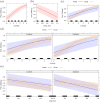Curiosity-driven learning in adults with and without dyslexia
- PMID: 34293988
- PMCID: PMC8600593
- DOI: 10.1177/17470218211037474
Curiosity-driven learning in adults with and without dyslexia
Abstract
People are willing to spend time and money to receive information and content they are curious about, such as answers to trivia questions, suggesting they find information rewarding. In neurotypical adults, states of high curiosity satisfaction are also known to enhance the learning and memory of information encountered in that state. Here, we investigated whether the relationship between curiosity, satisfaction, and learning was altered in a group with specific learning difficulty (dyslexia). Using a willingness-to-wait paradigm, we observed that adults with and without dyslexia are willing to spend time waiting for verbal and visual information. This indicates that the same "wanting" mechanisms are seen in individuals with dyslexia for information. We then examined whether information that was desirable was also associated with enhanced memory. Our findings indicate that information does function like a reward, with the gap between expected and received information driving memory. However, this memory effect was attenuated in individuals with dyslexia. These findings point to the need to understand how reward drives learning and why this relationship might differ in dyslexia.
Keywords: Curiosity; dyslexia; trivia; vocabulary.
Conflict of interest statement
Figures



References
-
- Bains A., Barber A., Nell T., Ripollés P., Krishnan S. (2020). Stage 1 Registered Report: The role of intrinsic reward in adolescent word learning. Developmental Science. 10.17605/OSF.IO/HKN54 - DOI - PubMed
-
- Bates D., Mächler M., Bolker B., Walker S. (2014). Fitting linear mixed-effects models using lme4. http://arxiv.org/abs/1406.5823
MeSH terms
LinkOut - more resources
Full Text Sources
Miscellaneous

